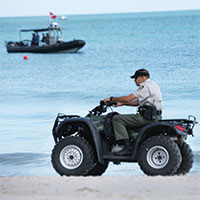 World War II bombs in ocean off The Moorings lead to evacuation
World War II bombs in ocean off The Moorings lead to evacuation
STORY
U.S. Navy Explosive Ordnance Disposal technicians safely moved two bombs apparently dropped by aircraft during WWII away from oceanfront homes on the barrier island on Monday.
Seven homes were in the potential blast zone just north of The Moorings and the area was evacuated while the bombs were lifted and taken out to sea.
“There were people home at two of the houses and they cooperated and evacuated with no problems,” said Assistant Indian River County Fire Rescue Chief Brian Burkeen.
Detected in shallow water near the beach by Army Corps of Engineers contractors, the bombs were excavated by Navy divers and lifted with air bags. One bomb weighed approximately 1,000 pounds; the other 500 pounds.
“The bombs were suspended beneath the float and the float was towed a mile offshore,” said Burkeen, who was coordinating onshore activates from a command post in Round Island Park. “The ordinance will be blown up out there tomorrow in 30 feet of water by attaching explosives to them and detonating the explosives.”
Burkeen said the county and U.S. military undertook a similar operation back in the late 1990s when bombs were discovered in an earlier sweep of the coast.
Last summer, the Indian River County Commission gave the Army Corps of Engineers permission to use a portion of Round Island Park for coastal access if needed to remove old World War II landing craft obstructions and explosives from shallow water along the county’s seacoast.
A Corps representative told the commission in June that a stretch of beach extending from Vero to Jensen Beach was part of the 19,000-acre Fort Pierce Naval Amphibious Training Base.
“The base fulfilled two primary missions during World War II,” the representative said. “Its original mission was amphibious training, including training the first Navy frogmen in the use of underwater explosives.”
Later, Vero’s beaches were used to develop new amphibious assault techniques based on lessons learned early in the war by the army in North Africa and Italy and by the Marines in the South Pacific.
“During 1943, the joint Army-Navy Experimental and Testing Board was established to develop and test procedures for breaching and removing beach fortifications expected to be encountered in Europe and Japan,” the representative said. “Beaches were fortified in the northern portion of the base and a variety of ordinance was tested against the fortifications.”
The bombs removed today may have been dropped to gauge their effectiveness in destroying coastal obstructions like those U.S. troops would face in the D-Day assault on Normandy and possible invasion of Japan.
The Army Corps has been removing jagged concrete and steel obstructions and unexpended explosives for the past 60 years, in a series of sweeps that began in the 1950s.
The test fortifications ranged from simple steel beams stuck up at an angle to spiked concrete and steel structures known as horned scullies that weigh up to 16 tons. Some of the fortifications had explosive charges attached that remain undischarged.
The Corps representative told the commission most work in the current sweep will be done from barges with attached cranes. Engineers drag magnetometers that detect metal along the shore. When metal is found it is examined by sonar. If fortifications that need to be removed are discovered, divers descend to attach chains to the objects which are then hoisted aboard the barges.
Burkeen said when Corps contractors recently determined they had found unexploded bombs, they brought in the Navy to remove and detonate the explosives.
Work on the project, known as the Defense Environmental Restoration Program, began on June 3. It will be wrapped up and described in a report sometime later this year.
The project manager said this is expected to be the Corps final sweep of the barrier island coast.








